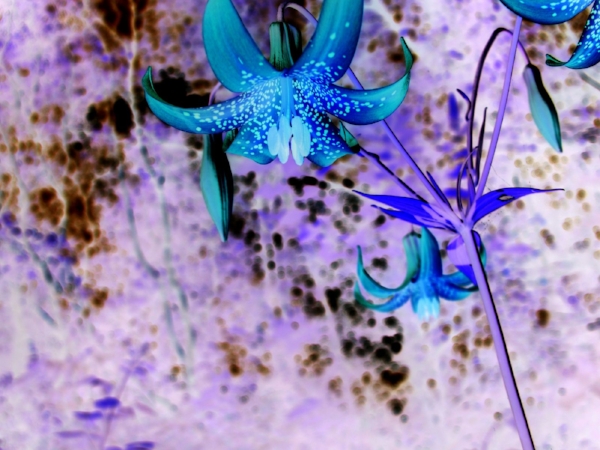Sacred Plant ID
~Beyond Latin Nomenclature
I have spent more than two decades now studying plants and their medicines. These years have been a great journey that has had many utterly beautiful gifts as well as many intense and growth generating challenges. Every person’s experience and contact with the green nations is unique and for me it is always a sacred activity. By sacred I mean that I have found the beauty, character, qualities, and healing virtues of plants, as well as the whole of nature, to be a dimension of divine creation that, if we are reverent and conscious of, we can become connected with. It has been my experience that with patience, practice, devotion and a heart-centered focus we can begin to perceive and become aware of our innate capacity to understand a meaning and significance of what would normally be invisible or disregarded.
If we were to put this into the words of depth psychology and the visionary psychologist Carl Jung, we would be connecting to the archetypal patterns of nature as they exist in plants, our relationship to nature, and our human interconnection with these patterns. An archetype is the pre-material, ethereal, and eternal essence or blueprint of a form or symbol. I correspond this to the mycelium or genetic substance of that which becomes embodied or temporal. This is information from beyond the hard angles and structures of space and time that is non-linear and mutable, or mythological. The archetype is the true substance that is beneath the surface and the form is the fruiting body. Another way to understand archetypes (and I read or heard this somewhere a long time ago and I don’t remember who to attribute it to) is like this: If you kill one rose blossom you haven’t killed the entirety of ‘Rose’ as a species. The qualities and information necessary to create more roses exist beyond the physical substance of the individual and yet is contained in them all.
There are many ways to study, learn and relate to plants and I don’t believe there is only one way to form a sacred connection and relationship, but I have discovered that there are methods that lend themselves to the possibility of an interface with the eternal world and sacredness of life more than others. Certainly, any activity that is intuitive, instinctual, imaginative and non-analytical that can help us shake off our modern, comfortable habit of categorizing, classifying and intellectualizing information in a reductionist manner, will cultivate an archetypal and mythological perception of the multi-layers of experience. It’s not that I don’t think these processes, including reductionism, don’t have their merits, as well as being necessities and survival skills that we must have at least some proficiency in order to navigate our current reality. It’s just that they’re not necessarily conducive to sacred relations and have become the dominant paradigm at the nearly complete sacrifice of most all other methods and systems.
I, for one, have spent a great deal of time, energy, and brain power learning and remembering the latin names of plants, as well as using keyed guide books with botanical classifications and I will continue to do so. This is important and is a valid and applicable practice that should not be neglected if we hope to carry the wisdom and knowledge of plant medicine into the future. This is not about determining “either/or”, but I have found that when I enter into the woods, wilds and gardens with my guide book and latin names, I engage different cellular grooves or sensory gateways than when I use my intuitive and non-linear skills. I also, I must admit, do find it a bit boring, tedious and, I’d even say, colonial, as if I’m trying to conquest, box up, fence in, and nail down the truth of something wild. I prefer the mysterious and enchanted possibilities of a nature that belongs to itself and that cannot necessarily be named or quantified in human terms.
Below are some ways in which I engage my intuitive and sacred senses to connect and commune with plants in the wild. I don’t discourage anyone from continuing to practice more orthodox methods of plant id(I’m still working on that latin), and I definitely recommend that you positively ID any plant practically to a scientific taxon before ingesting. I do, however, encourage you to cultivate plant relationships that are as deep and vast as all that is ordinarily unseen. This can be done with plants that you have already identified conventionally and want to get know on another dimension. Also, I often use some of the below ideas first and then go back with my plant id book.
Setting out
Instead of starting with the intention of identifying a plant or plants, set the intention to connect with nature and see if a plant calls to you. There are many ways to know if a plant is calling and we all have different sensory strengths and weaknesses that will create an impulse within us. Sometimes it is the beauty of a certain flower, the scent, or the color. Sometimes it’s the placement, like a plant that comes up through a sidewalk crack right where we stop to rest for a moment. Or a plant that shows up in our garden that we didn’t plant and has never been there before. It may be a plant that gives us a feeling of peace or passion or inspiration or love. It may be that we don’t know why but we’re really attracted to it.
Place and community
Notice where does this plant grow? A dark forest, a field, a city park, suburban backyard? Near people? What other plants grow around it? A plants community is part of its story and the context that it chooses to live within.
Introduce yourself and make an offering
You wouldn’t walk up to another human without offering some form of greeting, and although some would say that this is anthropomorphizing, as a human, I don’t know how else we should be expected to orient ourselves. Many indigenous traditions around the world had words and greetings with which to introduce themselves to plants and other non-human beings. Along with saying “hello”, making a formal offering enacts a relationship of reciprocity and humility. Offerings can be anything from a piece of your own hair, your breath, some cornmeal, tobacco, sea shells, stones, etc. Please keep to natural and non-toxic materials.
Prayer
An offering can include a prayer, a song, a dance or any other form of self-expression. Along with your prayer you can offer smoke from incense or a plant bundle. If you have a prayer style or tradition you follow make an offering from that practice. It is my recommendation that you do not use a prayer, language or blessing practice from a culture to which you have not been enculturated into. This is considered cultural appropriation and our American First People are offended by this. It is taking something that does not belong to you and it denies your own inheritance and ancestry while also offending your own lineage and history. This is an entire topic that is beyond our scope here, and my best advice is to be authentic and act from the heart of who you are no matter how you choose to express yourself. Your intention is the most important element of prayer.
Create a ritual
Initiate your own practice or sacred routine that you perform while studying and identifying a new plant. This can include a saying a prayer or chant, setting up a small alter, placing a talisman, small statue or figurine, or gem such a quartz crystal near the plant while you are sitting with it. Burning a plant bundle or invoking a particular guide or ancestral ally.
Engage the senses
What does the plant feel like? Slippery, soft, fuzzy, sharp, stingy(nettles comes to mind)? What does it look like? A woman, a man, a sufi dancer, a type of bird, a whirlwind, etc? What does it sound like when the wind blows through it or when you brush by it? What, if any, emotions do you experience when you sit with it or look at it?
***For more on engaging the senses read: The Earth Path, by Starhawk and Plant Intelligence and the Imaginal Realm, by Stephen Buhner
Interpret the leaves and flowers
Do the leaves or flowers form a symbol such as a spiral, a cross, curves and circles? Do the flowers point to the four directions? Do they have 5 points like stars? What do these symbols represent? Can you find correspondences to symbolic languages such as runes or ogham? Ogham itself is the ancient language of the Celtic Nations that is based on symbolic markings that represent trees.
Daydream
Set the intention to get to know the plant and allow your mind to wander and dream. If images or stories come up either draw them or write them down.
Night dream
Go to sleep with an image or a piece of the plant that you are working with and set the intention of learning more about it. Keep a pen and notebook near your bed to write down any dreams.
For great info on dreams and dreaming go to: toko-pa.com
Flow of consciousness
Sit with the plant and write a flow of thoughts. Just let them go and see what comes up.
Make up a story
Write a new myth or formulate a character around the plant. What type of personality would he/she have? Where would his/her kingdom be?
Make up a name
This is one of my favorite ways to remember and connect with local plants and it links us to a time when we lived more rooted in our bioregions and communities. Common names define a plant based on many variable including how it has emerged locally and how the local people perceive it. A common name acknowledges the spectrum of appearances that a plant can embody as well as the way it reflects the people in its community.
Try these and come up with your own ways to meet, connect, know and honor our great plant earth allies. We are blessed in our times to have so many roads to understanding our world. We have all that we have inherited from the past ways of direct observation, intuition, instinct and the honing of our natural senses to the greatest of technological innovations that include plant ID guide books and even cell phone apps. Whatever you choose can be made sacred by applying conscious awareness and reverence for all the ways with which we can know our world.




